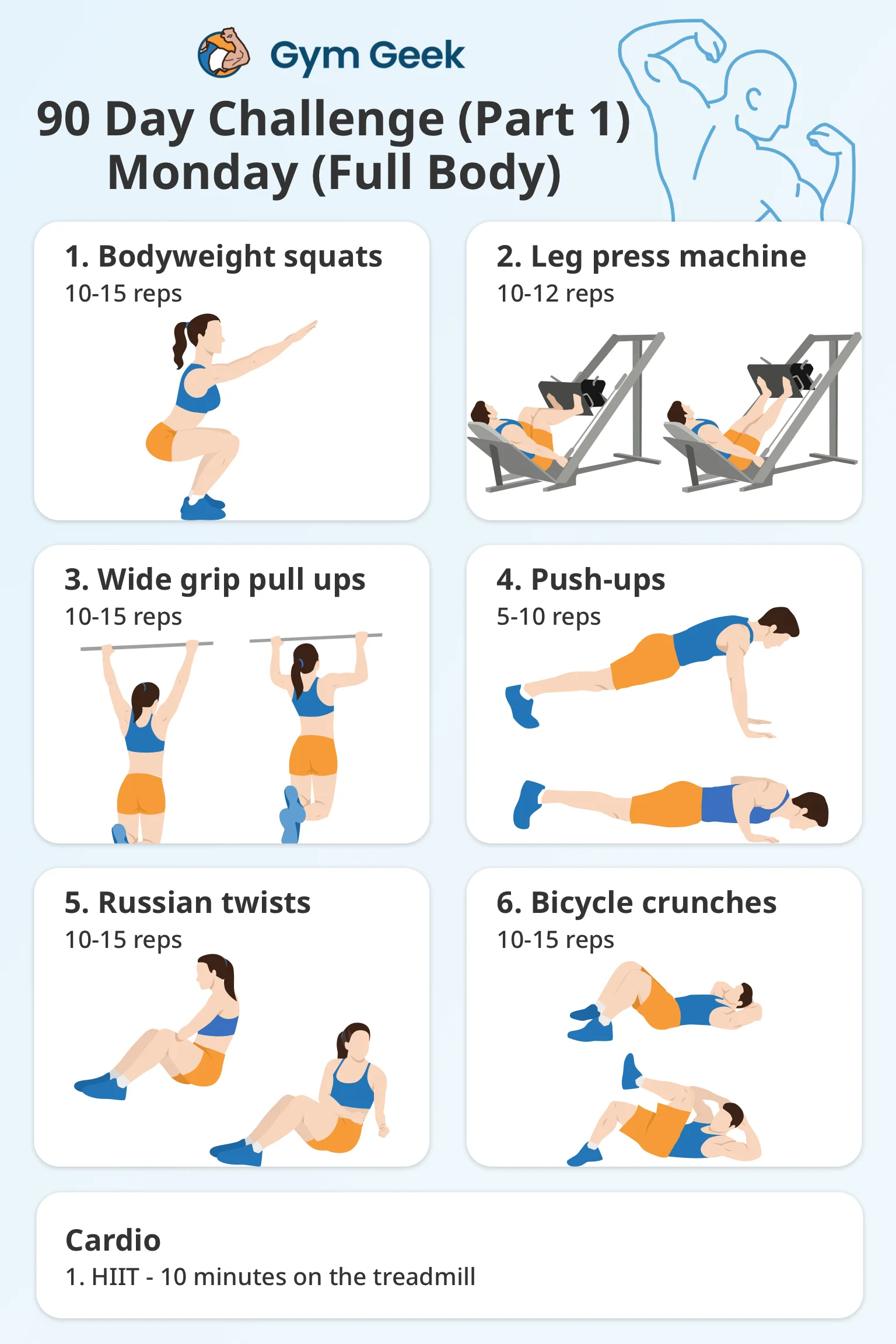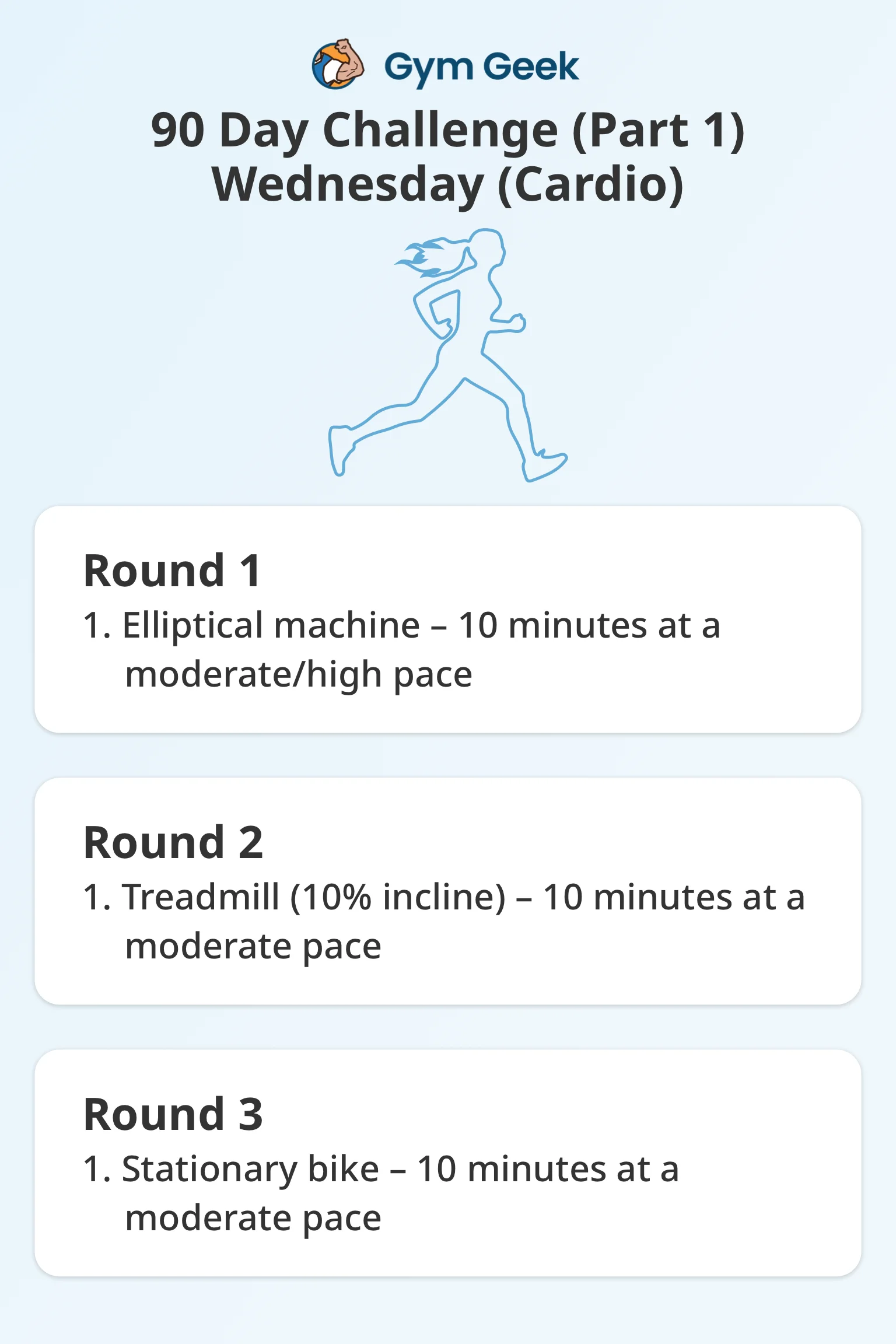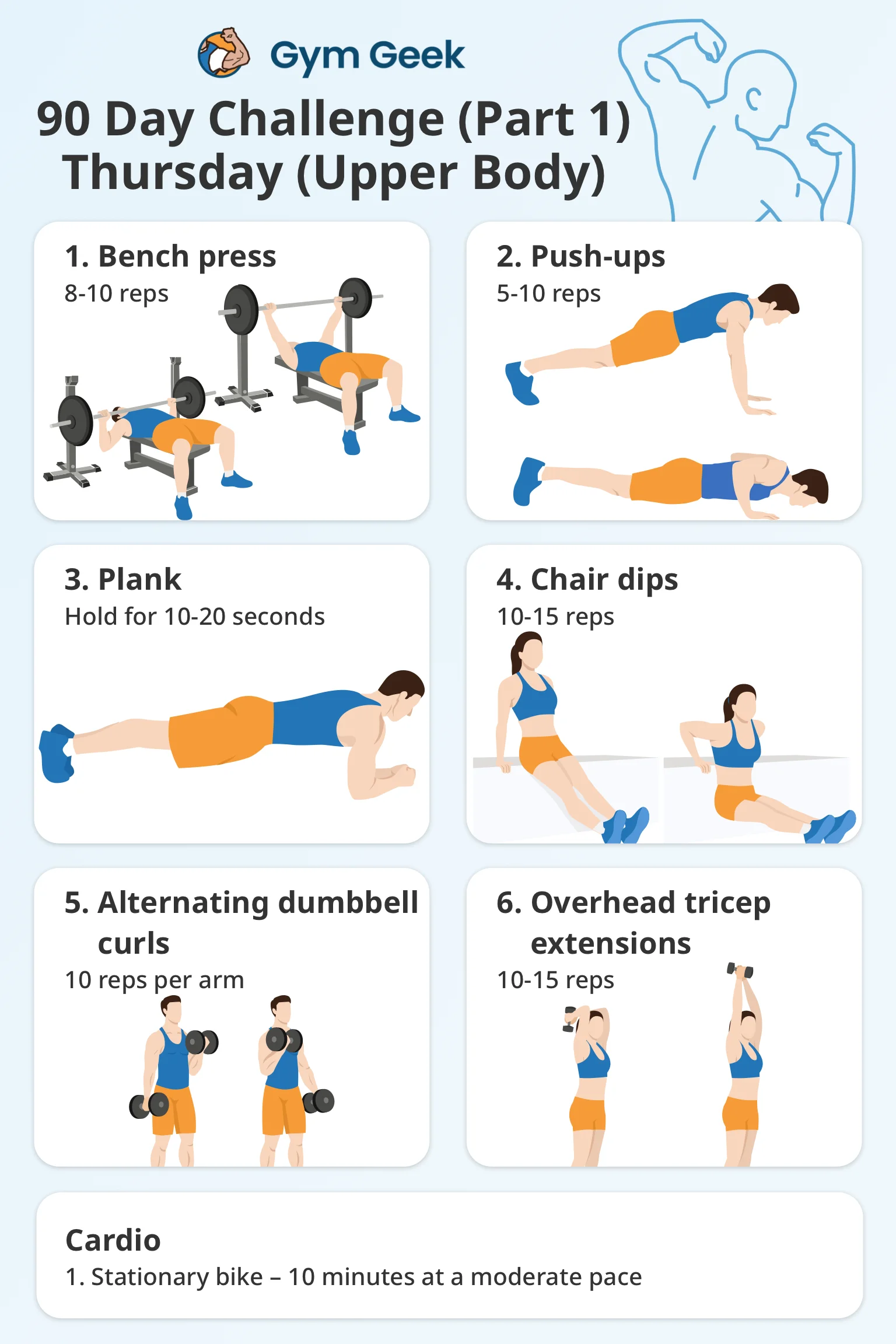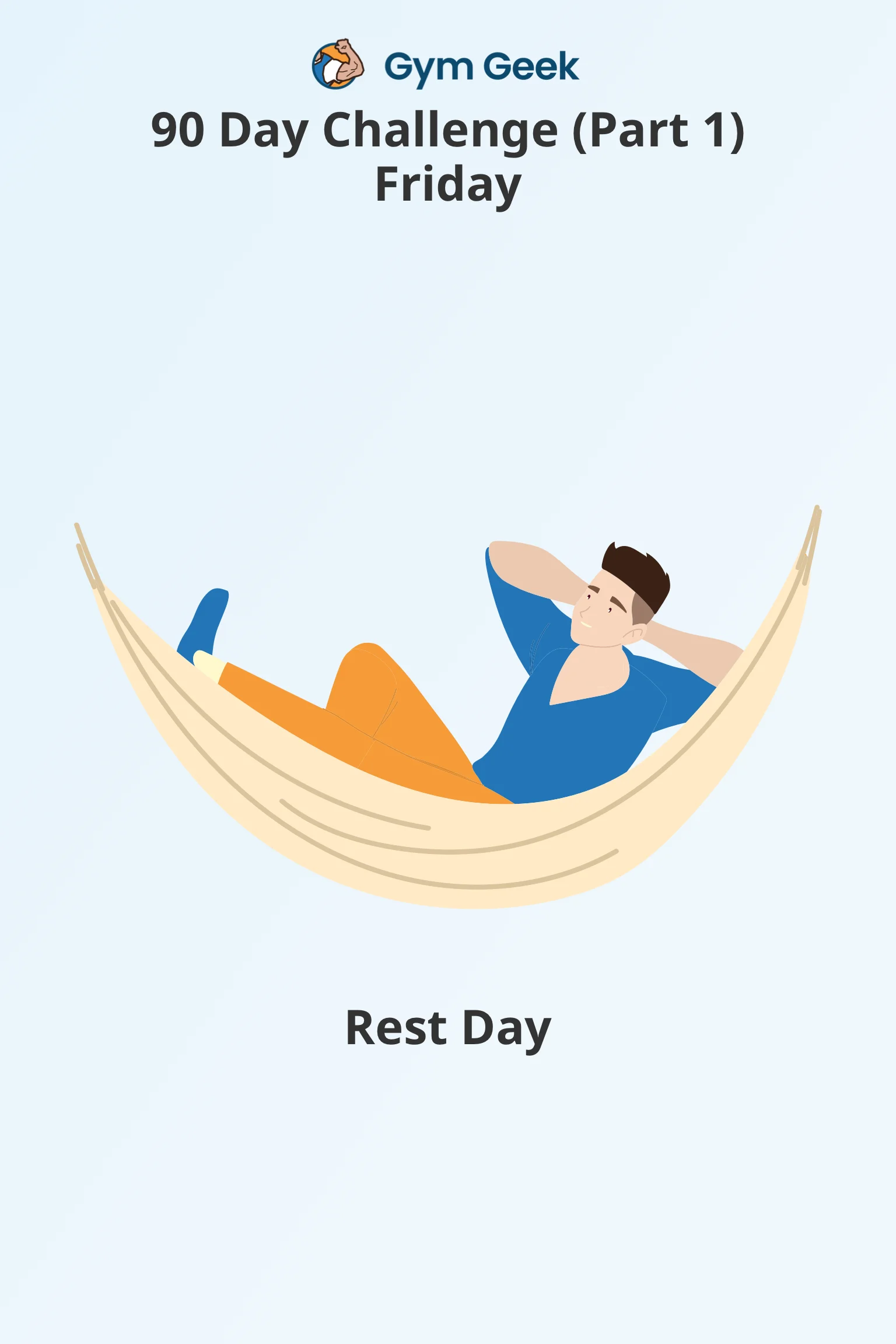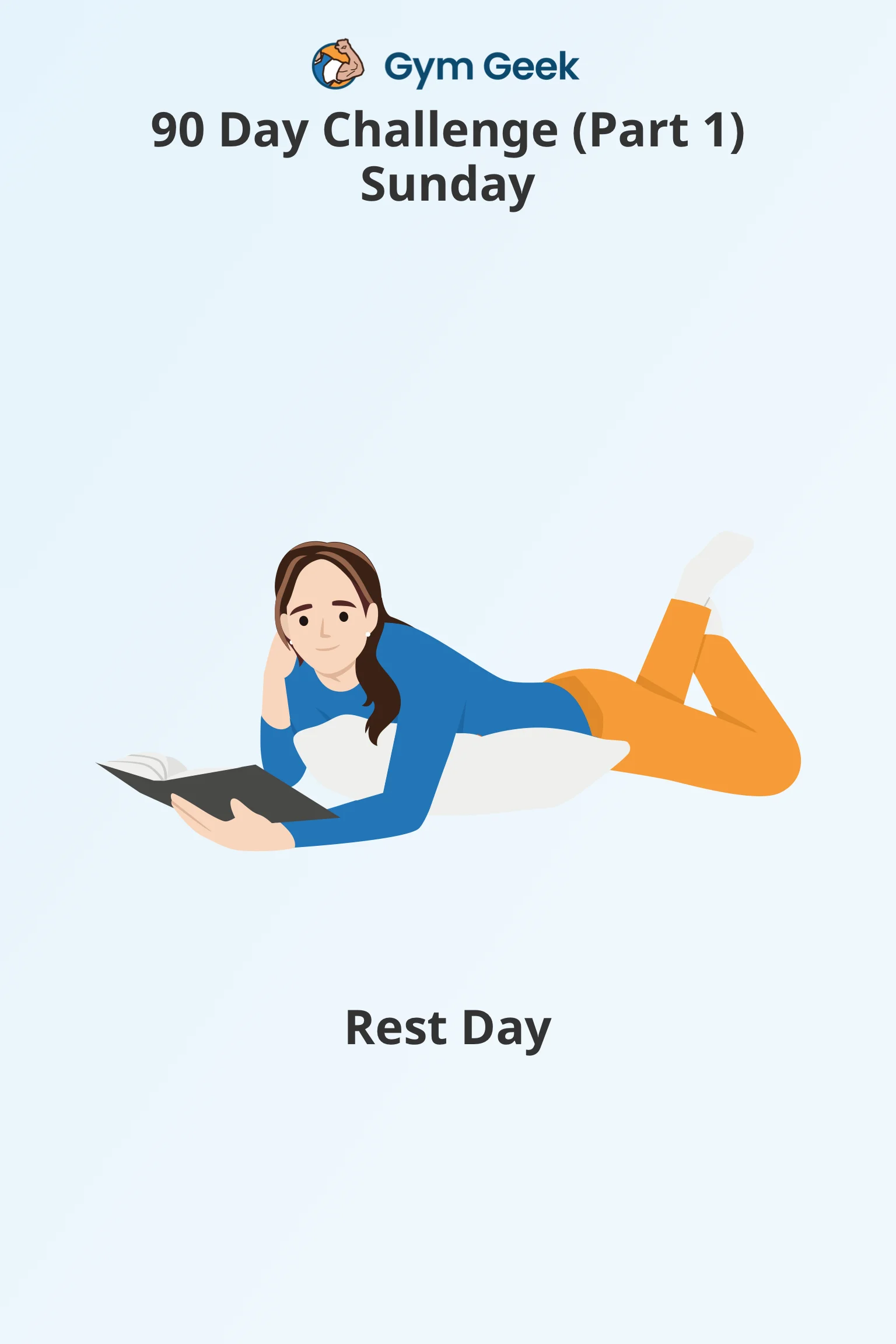90 Day Workout Plan – Beach Body Challenge
Looking to lose weight, build muscle or get in shape for the summer? Gym Geek’s 90 day workout plan targets your whole body and takes just 30 minutes a day!
Suitable for beginners • Lose up to 2 lb (1 kg) per week • Plus: Diet and nutrition guide

via Gumroad.com - Download this workout plan without ads, for free by entering $0 or name a fair price.
Our 90 day workout plan is a great way to get in shape for the summer. This plan is suitable for beginners, and includes exercises that target your whole body. The workout plan has 3 stages, featuring compound body building exercises, fat-burning cardio and individual body part muscle chiseling. And it takes just 30 minutes per day!
Jump to
- Eating healthy during a 90 day workout plan
- Structure of the 90 day workout plan
- Stage 1: The Five Week Foundational Workout Plan
- Stage 2: The Four Week Schedule
- Stage 3: The Three Week Shred
The secret behind 90 days
Are you aiming to transform your physical fitness and/or appearance? Are you looking to lose weight, build muscle or simply establish a regular exercise habit?
If so, starting a 90 day workout plan could be the key to your success. Here's why:
- Clear end goal - Many people find that having a realistic timeline with a clear end point motivates them to achieve their goals.
- Time for change - It's well understood that it can take about 3 months to see significant changes in your body composition or physical health.
- Lasting habits - By following a long term workout plan, you are more likely to establish positive exercise habits. "Crash workout routines" may deliver short term results, but might not create the long term change in habits.
Reasons to choose a 90 day plan
90 day workouts and challenges have been developed and refined by fitness experts over time. Gym Geek's 90 day workout routine is designed to be accessible for a wide range of fitness levels.
Our challenge is a great choice for beginners, as the plan gradually increases in intensity over time. This makes it a great starting point for those just getting into fitness.
The 90 day challenge is not a suitable choice for everyone, however. Those with medical conditions or injuries should consult a doctor or medical professional before starting any new exercise program.
Access to a gym
You'll need access to a gym for this workout challenge. If you are looking to workout at home, you can instead follow our 8 Week Bodyweight At Home Workout for Beginners program. If you are looking for more intensity, you can also consider the 3 Day a Week Full Body Workout.
It is important to set realistic goals for the 90 day challenge. Breaking your goals down into smaller goals is a great way to not feel overwhelmed or discouraged by your progress.
Set your 90 day goal
Take some time to think about what you would like to achieve in your fitness challenge. Picture yourself in 3 months time and ask what you would like to be true?
Here's some goals you might consider:
- Lose weight - If you are currently overweight or obese (try our BMI calculator), losing some weight can make a positive to your health and wellbeing. The biggest factor in losing weight and maintaining a healthy weight is in fact diet, so you'll need to eat well alongside any fitness plan. We'll talk more about diet and nutrition later...
- Get in shape - Start in March, and you could have a beach body by June! The first 5 weeks of our routine are about building foundational body strength. But then we'll include some high rep, "muscle chiseling" isolation exercises to enhance your body shape and muscle definition.
- Better health - Our 90 day challenge includes both strength training and cardio. Strength training builds muscle mass, increases your metabolic rate and increases your bone density. Cardio completes this by promoting heart health, helping with weight loss and weight management and improves you overall fitness level. The Physical Activity Guidelines recommend that healthy adults do at least 150 minutes of moderate aerobic activity or 75 minutes of vigorous aerobic activity each week.
How much weight can I lose in 90 days?
To lose weight alongside the 90 day workout plan, you will need to maintain a calorie deficit. Using our calorie calculator, you can estimate the number of weeks it will take to reach your goal. The calculator will provide deficit estimates for between 0.25 kg (0.5 lb) and 1 kg (2.2 lb) weight loss per week.
Important: Remember to set the activity level to "Moderate Activity or Exercise" as this will accurately reflect the intensity of our 90 day workout plan.
Diet and nutrition
Eating healthy is essential when following any fitness plan. Proper nutrition can maximize the results of your workouts, and help you achieve your goal faster. Food provides the fuel your body and muscles need, help you build muscle and lose weight in a safe way. Any diet needs to match the intensity of your workout plan.

You should include plenty of fresh fruit and vegetables in your diet, alongside lean protein sources like fish and chicken. While it’s important to avoid highly-processed foods and sodas, it’s okay to opt for healthy snacks like almonds and walnuts as snacks.
Staying hydrated is also key to maintaining good health during a workout or weight loss plan.
You may wish to track your progress with a food journal or calorie tracking app like MyFitnessPal. Calorie tracking can be an effective way to lose weight in a safe way, and gives you insight into the foods you eat and your macronutrient intake.
A healthy diet is just as important as exercise when following a workout plan. Foods provide the energy you need for workouts, and a healthy diet can reduce cravings for unhealthy snacks.
Types of foods
It’s essential you get the nutrients your body needs to achieve your outcomes in a sustainable and healthy way. A great diet to follow focuses on lean proteins, complex cards, fresh fruits and vegetables and low-fat or zero-fat dairy.
Good choices for lean protein include fish, chicken, turkey and lean cuts of beef. Protein is an important nutrient for muscle growth and repair. Eating additional protein can also help you feel full, aiding your weight loss journey.
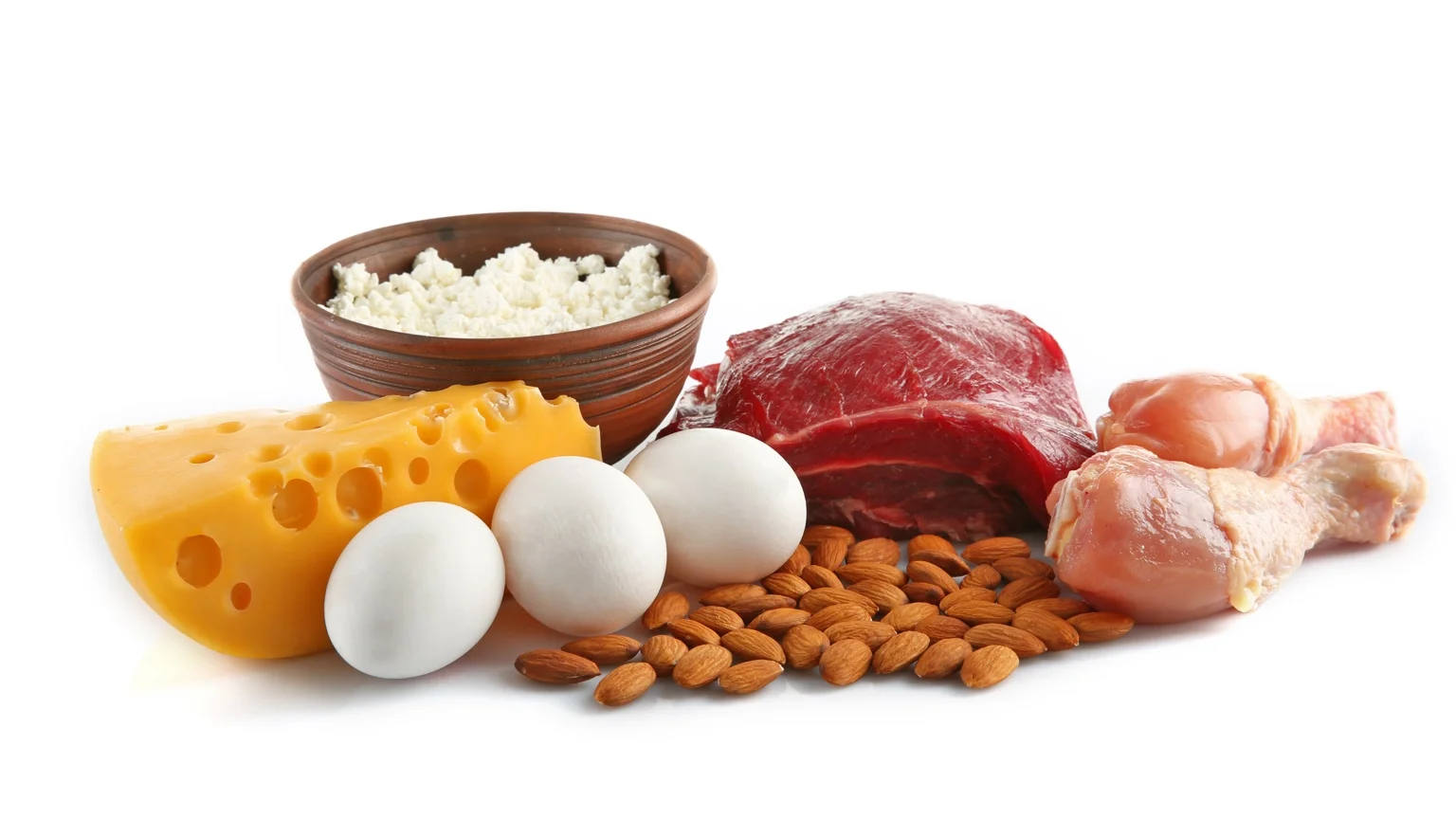
Complex carbs should make up most of your calorie intake. Complex cards include whole grains like brown rice, quinoa and oats. These are great choices, as they provide a slow release of energy, compared to simple cards that can cause blood sugar spikes.
Fresh fruits and vegetables are important to include in your diet as they provide vitamins, minerals and fiber your body needs. Leafy greens, brocolli and other vegetables are great choices for many meals. Fruits can include apples, oranges and bananas, and make great snacks between meals. You should aim for at least 5 portions of fruit and vegetables per day.
Finally, low-fat dairy can be a great choice, including yogurts and milks. Dairy can be a great source of additional protein, which can help your feel fuller for longer.
Foods to avoid
Fast food is the enemy of weight loss. Try to avoid burgers, pizzas and fried foods. Also avoid other foods that are particularly high in fat or have high calorie density. Diets that include lots of fast food can increase weight gain.
You should also avoid foods that are high in sodium, which includes many potato chips and candy bars.
While it’s important to limit your intake of unhealthy foods, you do not need to entirely eliminate treats and snacks from your diet. You should aim to enjoy unhealthy foods in moderation, to build sustainable and long-term habits. For example, rathe than eating a whole bag of potato chips, you can choose to eat a measured portion.
Success on the 90 day workout plan depends on a healthy diet, made up of plenty whole foods and good portion sizes.
Protein and macros
There are 3 important macronutrients - protein, carbohydrates and fats. Protein is important for muscle growth and repair. Carbs give your body energy, including when you are exercising. Fats are the slowest source of energy, providing energy for long-duration but low-intensity exercises.

To maintain or grow muscle mass while losing weight, it’s important that you consume enough protein in your diet. Protein is a key macronutrient involved in the growth and repair of muscle tissue. A protein intake of between 1.2 g and 1.6 g per kg of bodyweight should be sufficient for most people.
Balancing your macronutrients is important when cutting calories. You need to make sure you are getting a sufficient amount of carbohydrates, fats and proteins to fuel your body. The standard ratio is 50% carbohydrates, 30% fats and 20% protein, but this might not provide enough protein if you have a large calorie deficit.
You can use a macro calculator to get a custom recommendation. This calculator takes into account your height, age, gender, activity level, as well as your current weight and weight goal. It ensures that your macros hit the recommended intakes of carbs, proteins and fats.
TDEE Calculator
You should also consider whether a calorie goal is right for you. The number of calories your body uses per day is known as the total daily energy expenditure (TDEE). A typical calorie deficit plan sees you target 500-1000 calories below your TDEE. A calorie deficit is suitable if weight loss is your goal. You should aim to lose no more than 1 kg or 2 lb per week.
Structure of the 90 day workout plan
The 90 day workout plan consists of a sequence of compound body building exercises, individual body part muscle chiseling and cardio each day.
- First 5 weeks - The first 5 weeks focus on compound body building movements. These exercises target multiple muscles and muscle groups, and build a foundational strength for the workout plan.
- Weeks 6-10 - Between weeks 6 and 10 you will focus on high rep compound movements, alongside moderate fat-burning cardio. These exercises can increase your metabolism, burn more calories and help you achieve body shape.
- Week 11+ - From week 11 onwards, you will perform high rep, individual body part muscle chiseling alongside cardio. This part of the plan further enhances your body shape and muscle definition, and gives your muscles an extra challenge to increase strength.
In the first 5 weeks, you will be working out 5 days per week. From week 6 onwards, you will exercise 6 days per week with one rest day each week.
5 days a week can be an intense plan for some people. If you are just starting out on your fitness journey, you may want to start with 3 days of exercise per week and add days as your fitness level increases. It’s important to listen to your body and take the right amount of rest.
Rest days are important as they give your body a break from the physical stresses of exercise. Taking rest days also reduces the risk of overtraining, because it gives your muscles a change to recover. In addition to avoiding injury, you may also feel less fatigue if you take regular rest.
The Muscle Confusion Principal
The Muscle Confusion Principle says that, when you train your body the same way day in and day out, your body starts to adapt to the routine. And so the routine gets easier to perform.
When this adaptation happens, often the trainee either reaches a plateau and notices they’re making very little progress or they find ways to change their workout routine.
This is where muscle confusion comes into play, because as you vary the muscle groups you’re working each workout, your body doesn’t adapt as easily… simply because it can’t… and this is the main principle behind this entire routine.
Okay, time to detail the 90 day workout routine...
There's three stages you can jump between - the first 5 weeks, weeks 6-10 and weeks 11+.
Have a question?
- First - Scroll down to the bottom of the page. There's a list of frequently asked questions that may have the answer.
- Then - If the question isn't answered, head over to our forum and ask the question there. We're here to help!
Stage 1: The Five Week Foundational Workout Plan
Monday - Full Body
Repeat this routine 1-3 times depending on your ability. Try to complete all 3 circuits by the end of the 5 week workout plan:
- Bodyweight squats – 10-15 reps
- Leg press machine – 10-12 reps
- Wide grip pull ups – 10 – 15 reps
- Push-ups – 5-10 reps
- Russian twists – 10-15 reps
- Bicycle crunches – 10-15 reps
Cardio:
- HIIT – 10 minutes on the treadmill
Tuesday – Rest

Wednesday – Cardio circuits
Round 1:
- Elliptical machine – 10 minutes at a moderate/high pace
Round 2:
- Treadmill (10% incline) – 10 minutes at a moderate pace
Round 3:
- Stationary bike – 10 minutes at a moderate pace
Thursday – Upper Body Focus
Repeat this routine 1-3 times depending on your ability:
- Bench press – 8-10 reps
- Push-ups – 5-10 reps
- Plank – Hold for 10-20 seconds
- Chair dips – 10-15 reps
- Alternating dumbbell curls – 10 reps per arm
- Overhead tricep extensions – 10-15 reps
Cardio:
- Stationary bike – 10 minutes at a moderate pace
Friday – Rest

Saturday – Lower Body Focus
Repeat this routine 1-3 times depending on your ability:
- Bodyweight squats – 10-15 reps
- Leg extensions – 15 reps
- Reverse lunges – 10-15 each side
- Standing calf raises – 10-15 reps
- Hamstring curls – 3 sets of 15 reps
Cardio:
- Elliptical machine – 10 minutes steady-state cardio
Sunday - Rest Day

Tips
It’s important to note that you have to do three things during these workouts for them to be the most effective:
- Take just enough time between sets to change the amount of weight you’re using for each set
- Try to go to failure on your last two sets
- Take advantage of Your “Rest Days” by resting and recuperating properly
- It’s also important to either train with a partner or make sure that you ask someone to spot you for your own safety.
This five week routine is also designed for the weight trainer in mind, someone who should be able to use different movements for each body part.
In other words if you did flat bench presses during week one, then week two you could do dumbbell bench presses or decline or incline bench presses.
For the back muscles you can try T-Bar rowing, seated rowing or barbell bent rows, but you get the idea. Each week you’ll use a different exercise movement to keep your muscles confused and keep your mind interested enough to push through each set within the 30 minute time frame.
Stage 2: The Four Week Schedule
This is where things get a little tougher, and the reason why is because there’s only two “off days” during this four week cycle and cardio is a full 20 minutes with a day of its own as well as the 30 minute allotted time frame to complete a workout per day.
The routines that you’ll be doing during this cycle still involve compound movements, but we start to turn up the heat a bit more as we add more reps to each set along with 12-15 minutes of cardio per workout.
The central idea of this workout schedule is simple; same amount of sets, but reps using slightly less weight to attain those extra reps per set.
Monday – Cardio and full body
Full body workout:
- Seated dumbbell shoulder press – 4 sets of 15 reps
- Wide grip pull ups – 4 sets of 12 – 15 reps
- Push ups – 4 sets of 20 reps
- Bodyweight squats – 4 sets of 20 reps
- Triceps extensions – 4 sets of 15 reps
- EZ bar curls – 4 sets of 12 reps
Cardio:
- HIIT – 20 minutes on the treadmill
Tuesday – Bodyweight circuits
Round 1:
- Squat thrusts x 20
- Push ups x 20
- Sit ups x 20
Repeat three times and rest for 2 minutes.
Round 2:
- Bodyweight squats x 20
- Walking lunges – 10 per leg
- Spiderman push ups x 20
Repeat three times and rest for 2 minutes.
Round 3:
- Hanging leg raises x 20-30
- Mountain climbers x 20
- Plank – As long as possible (30 seconds+)
Repeat three times and rest for 2 minutes.
Wednesday – Cardio circuits
Round 1:
- Elliptical machine – 15 minutes at a moderate/high pace
Round 2:
- Treadmill (10% incline) – 20 minutes at a moderate pace
Round 3:
- Stationary bike – 20 minutes at a moderate pace
Round 4:
- Stair climber – 15 minutes
Thursday – Cardio and full body
Full body workout:
- Alternating dumbbell curls – 4 sets of 10 reps per arm
- Lying dumbbell tricep extensions – 4 sets of 15 reps
- Leg extensions – 4 sets of 12 – 15 reps
- Standing calf raises – 3 sets of 20 reps
- Butterfly pec deck machine – 4 sets of 15 reps
- Dumbbell lateral raises – 4 sets of 15 reps
Cardio:
- Elliptical machine – 20 minutes steady-state cardio
Friday – Core and full-body
First workout:
- Smith machine incline press – 4 sets of 20 reps
- Barbell curls – 4 sets of 20 reps
- Bodyweight squats – 4 sets of 20 reps
- Seated shoulder press machine – 4 sets of 20 reps
- Triceps rope pushdowns – 4 sets of 20 reps
- Wide-grip lat pull-downs – 4 sets of 20 reps
Rest for 5 minutes.
Second workout:
- Lying leg raises – 3 sets of 20 – 30 reps
- Incline stomach crunches – 3 sets of 30 reps
- Oblique crunches – 3 sets of 30 reps
Saturday & Sunday - Rest Day
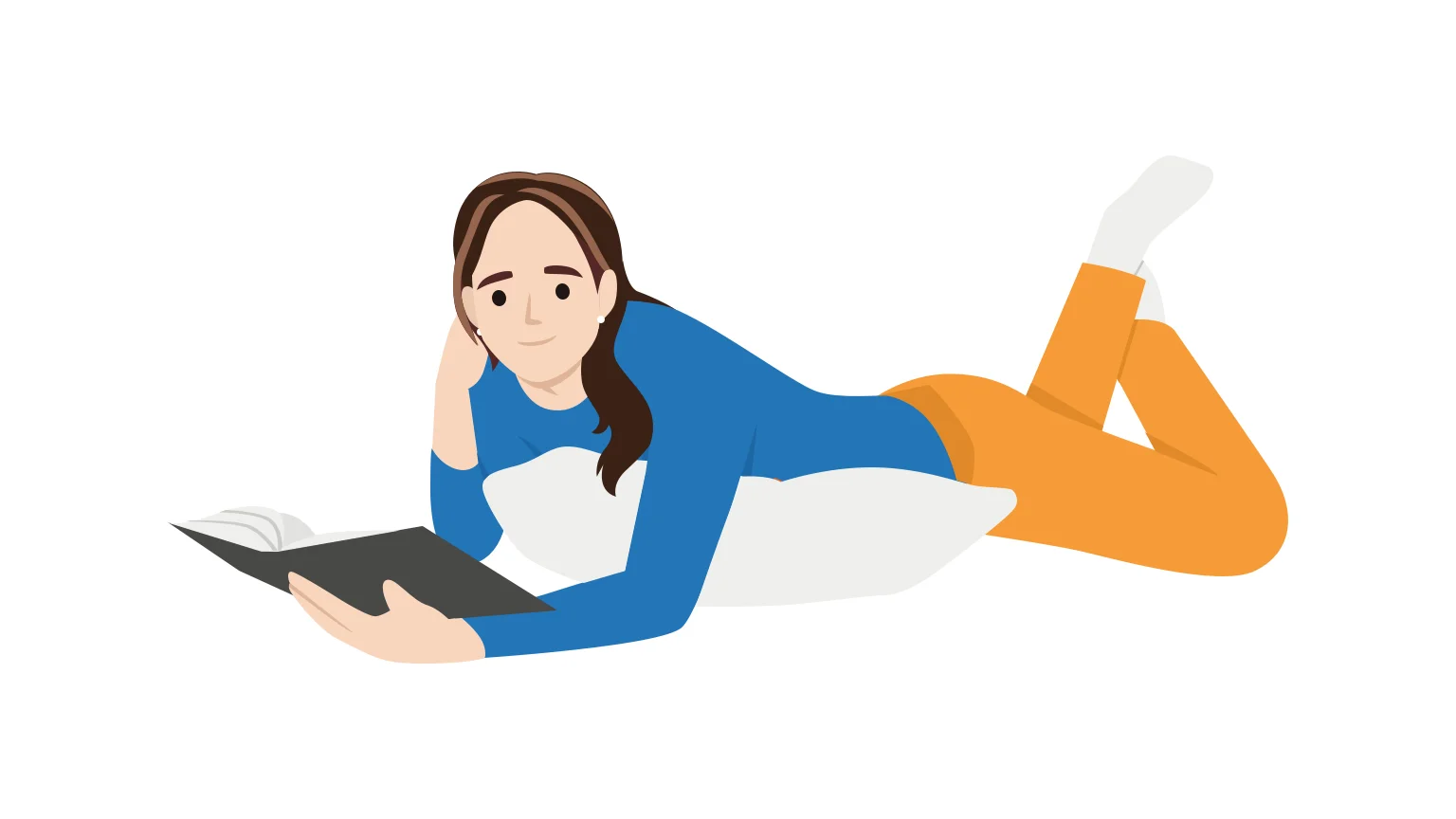
Stage 3: The Three Week Shred
This is where we separate the men from the boys so to speak. The final three weeks of training is all about targeting each individual muscle… and this is where the training is the hardest and most intense because we’re actually focusing on training almost on the level of a pro bodybuilder chiseling his muscles for maximum definition.
This cycle you’ll be training four days straight with one day off, and then back for another two days before a new week of training begins… without a break leading into that next week of training and don’t forget about that cardio for each workout.
Monday – Chest day
- Bench press – 4 sets of 8-10 reps
- Incline dumbbell press – 4 sets of 8-10 reps
- Incline dumbbell fly – 4 sets of 12 reps
- Cable crossovers – 3 sets of 15 reps
- Pec deck – 3 sets of 15 reps
- Push-ups – 3 sets of 15-20 reps
Tuesday – Shoulder day
- Standing military barbell press – 4 sets of 8-10 reps
- Dumbbell lateral raises – 4 sets of 12-15 reps
- Dumbbell front raises – 4 sets of 8-10 reps per arm
- Rear delt flyes – 4 sets of 12-15 reps
- EZ bar upright rows – 4 sets of 10-12 reps
- Dumbbell shrugs – 3 sets of 15 reps
Wednesday – Leg day
- Barbell squats – 4 sets of 8-10 reps
- Leg press machine – 4 sets of 10-12 reps
- Hack squat machine – 4 sets of 10 reps
- Leg extensions – 3 sets of 15 reps
- Hamstring curls – 3 sets of 15 reps
- Standing calf raises – 3 sets of 20 reps
Thursday – Back day
- Barbell bent over rows – 4 sets of 8-10 reps
- Close grip lat pulldown machine – 4 sets of 12 reps
- T-bar rows – 4 sets of 8-10 reps
- Dumbbell rows – 3 sets of 10 reps per arm
- Hyperextensions – 3 sets of 15 reps
- Reverse grip pulldowns – 3 sets of 15 reps
Friday – Arms day
- EZ bar curls – 4 sets of 12-15 reps
- Standing hammer curls – 4 sets of 10-12 reps
- Preacher curl machine – 3 sets of 10-12 reps
- Triceps rope pushdowns – 4 sets of 15-20 reps
- Triceps overhead extensions – 4 sets of 15 reps
- Close grip smith machine bench press – 3 sets of 15 reps
Saturday & Sunday - Rest Day

Okay so you should be able to go on your own from here. Remember that you’re going to finish off your second training week and go right into the third and final week of training four days on, one day off and two final days of training to finish of your final week of the program!
Frequently asked questions
What are sets and reps?
Sets and reps are terms related to strength training. Sets are the number of times you repeat a set of exercises. Reps (repetitions) are the number of times you repeat each individual exercise. For example, if you did 5 sets of 10 push ups, you will be doing a total of 50 push ups.
The goal of a strength training workout is to perform as many reps as possible within a specific target rep range. Suitable target rep ranges depend on the exercise and your fitness level. Most workouts target 6-12 reps. Fewer than 6 reps may not give your muscles enough stimulus for growth (hypertrophy). Doing more than 12 reps may increase the risk of injury to your body.
If you are able to consistently complete the upper end of a rep range (e.g. 12), you should consider increasing the weight for that exercise. Increasing weight challenges your muscles further, promoting more growth and strength. It is important you do not increase weight too much too fast, as this can increase the risk of injury.
If you are struggling to complete the rep target, you should consider decreasing the weight. This allows you to hit the target rep range with proper lifting form.
What is volume?
In strength training, volume is the total amount of “work done” during a session. It is based on the number of sets and reps performed, as well as the amount of weight lifted. Volume is important for strength training as it gives a clear indication of how much weight you are lifting, and helps you see overall progress between workouts.
The formula for volume is “Sets x Reps x Weight”. For example, if you do 6 sets of 8 reps lifting 20 lbs, the total volume is “6 x 8 x 20” which is 960 lbs of volume. You can also add the volume of multiple exercises together to get the total volume for a workout session.
For muscle building, volume is the most important factor in building muscle and making progress. To increase volume, you can add weight, increase sets or increase the reps for each exercise. You can also change the types of exercises in the workout plan to increase or decrease the total workout volume.
Volume is a great way to track progress over time and help you decide when to adjust your workouts. For this reason, it’s a great number to track when your goals are to maximize gains in strength and muscle size.

